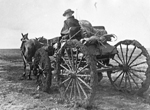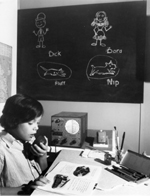A brief history
Distance has always been a challenge for education in Queensland. The state covers a vast area with communities small and large spread over many thousands of square kilometres.
|
 In the early part of the twentieth century the Department of Education implemented an itinerant teacher scheme. These intrepid souls travelled through the outback, in the early days often on horseback. They visited families with children and provided schooling, if only for a brief time and rarely more than three times in the course of a year. In the early part of the twentieth century the Department of Education implemented an itinerant teacher scheme. These intrepid souls travelled through the outback, in the early days often on horseback. They visited families with children and provided schooling, if only for a brief time and rarely more than three times in the course of a year. |
The development of a more efficient postal system made it possible to deliver educational materials to children all over Queensland via the post. The Primary Correspondence School was established in 1922. Another service saw Domestic Science and Manual Arts education delivered from travelling railway cars. This scheme ran from 1923 to 1967. There must have been great excitement when those trains came to town.
|
 From the 1960s and 70s isolated children also had access to lessons via School of the Air, using HF radio to interact with their teachers and classmates. As of 2005 all seven Schools of Distance Education deliver regular scheduled lessons via telephone, representing one of the most significant changes to the delivery of distance education in the last 30 years. The dramatically improved audio quality of telephone provides clearer reception and more reliable and consistent transmission. The Queensland Government committed over one million dollars to provide this enhanced communication medium as part of their ongoing commitment to the equitable provision of ICTs to all students. From the 1960s and 70s isolated children also had access to lessons via School of the Air, using HF radio to interact with their teachers and classmates. As of 2005 all seven Schools of Distance Education deliver regular scheduled lessons via telephone, representing one of the most significant changes to the delivery of distance education in the last 30 years. The dramatically improved audio quality of telephone provides clearer reception and more reliable and consistent transmission. The Queensland Government committed over one million dollars to provide this enhanced communication medium as part of their ongoing commitment to the equitable provision of ICTs to all students. |
Correspondence and print based learning materials have historically been the foundation of delivering education over distance in Queensland. Many and varied audio and video programs have also been developed specifically for use in the distance learning context, to support and enhance the print based materials. But over time emerging technologies are being incorporated into the range of possible delivery options.
Today, developers of distance learning resources are taking advantage of the opportunities offered by digital technology and the Internet. Video and audio resources can be delivered on CD-ROM or DVD. Whole courses can be delivered online. Learning objects offer interactive and engaging learning experiences around specific topics.
Whatever the reason that students are isolated from school, ensuring the best educational outcomes for those students will continue to depend on the the writing, development and production of effective and appropriate learning resources and interaction with dedicated and skilled teachers, be that via the post, telephone or email and the Web.
Here are some key dates for Distance Education in Queensland:
|
1901 | The Department appointed the first itinerant teacher who visited isolated homes to bring some elementary education to these children |
|
1922 | The Primary Correspondence School was established to provide lessons by mail for children in remote areas |
|
1932 | The itinerant teacher system ended |
|
1964 | Mt Isa School of the Air opened |
|
1966 | Charleville School of the Air opened |
|
1971 | Regular broadcasts of 'On Parade', radio program for children of the Primary Correspondence School |
|
1972 | Cairns School of the Air opened |
|
1973 | 'On Parade' no long broadcast, but monthly editions of the program sent to students by post on audio cassette |
|
1974 | The preschool correspondence program began |
|
1984 | A Ministerial Advisory Committee on Distance Education was appointed |
|
1985 | The use of technology to enhance distance education, work in schools and educational administration was supported |
|
1986 | The distance education satellite trial began through the Mt Isa School of the Air |
|
1987 | Two new centres of distance education opened at Longreach and Charters Towers. The distance education computer trial explored the use of computer software programs and email accounts by isolated students |
|
1989 | There was an amalgamation of correspondence schools, the Pre School, Primary and Secondary, which became the Brisbane School of Distance Education. The delivery of correspondence materials to distance education students was decentralised. Cairns and Charleville Schools of the Air became Schools of Distance Education |
|
1990 | Schools of Distance Education School Support Unit opened at West End, developing resources to support distance learning, in particular print and audio resources. |
|
1991 | Cairns School of Distance Education was established, formerly School of the Air |
|
1992 | Open Access Support Centre opened - to develop programs and provide educational opportunities for all learners using technology - centralised support unit to provide for the coordination and equality of services in distance education |
|
1993 | Capricornia School of Distance Education opened |
|
1997 | Charleville SDE commences trialling of telephone teaching |
|
1999 | AccessEd opened. A substantial part of AccessEd's work was the design and development of resources specifically for students of distance education, including print, audio and video materials. Digital technology also formed the foundation for developing interactive multimedia and web based teaching and learning resources |
|
2000 | The Virtual Schooling Services begins delivering courses online |
|
2001 | Telephone teaching commenced at Charleville SDE |
|
2002 | Courses delivered online for the first time via the The Learning Place, EQ's gateway for online courses and online communities |
|
2003 | Cairns, Capricornia and Charters Towers switch from HF radio to telephone teaching |
|
2004 | The Distance Learning Unit is established and continues the writing, design and development of a wide range of resources to support distance learning in Queensland |
|
2005 | Telephone teaching with its greater reliability, flexibility and teaching and learning opportunities replaced HF Radio across the state |
|
2006 | The Education (General Provisions) Act 2006 is introduced providing a legislative framework for the enrolment of students in schools of distance education. |
|
2007 | The Distance Learning Unit is integrated into eLearning Branch and is now known as Advisory Development Services. |
|
2008 | Schools of Distance Education take a greater role in the development of new learning materials to support the implementation of the Queensland Curriculum, Assessment and Reporting (QCAR) Framework in Years 1-9. |
|
2009 | A trial of the Department's new web conferencing system 'iConnect' is conducted in all schools, including schools of distance education to explore the possibilities of a real time, online collaboration solution that enables the communication and sharing of voice, video, applications and chat across the Internet. |
If you're interested in more information on the general history of education in Queensland visit the excellent
Education History website.